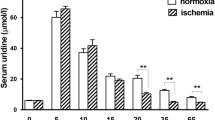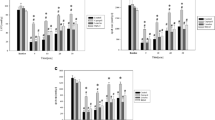Abstract
We investigated the effects of the xanthine oxidase inhibitor allopurinol and its metabolite oxypurinol on isolated rabbit hearts. To assess the potential role of these drugs in preventing reperfusion injury, hearts were perfused using Langendorff techniques, held globally ischemic for 3 h at 15°C, and then reperfused. During perfusion, hearts received Krebs-Henseleit solution maintained at 37°C. Aortic perfusion pressure was held constant at 80 cm H2O. Prior to ischemia, hearts were arrested with a constant volume of KCl cardioplegia. Using a left ventricular (LV) balloon, developed pressures were measured prior to and following global ischemia. In addition, coronary circulation (CC) was measured before and after ischemia. All hearts were paced at 260 beats/min. We studied four groups: group 1 received 1 mM allopurinol, group 2 received 1 mM oxypurinol, group 3 received 90 IU/ml superoxide dismutase (SOD) plus 8085 IU/ml catalase (CAT), and group 4 received no treatment and served as a control. Each group consisted of 8 animals. Hearts receiving drug treatment did so during the first 5 min of reperfusion. Displaying all data as a function of LV volume, postischemic values were compared to preischemic values. Multivariate analysis and Tukey tests were used to detect significant differences between groups. When compared to the control group, all drug-treated groups significantly recovered end-diastolic function. Peak systolic pressure decreased significantly in the SOD/CAT group as compared to all other groups. LV isovolumetric work decreased significantly more in the SOD/CAT and control groups than in the oxypurinol group. Coronary circulation decreased significantly in the SOD/CAT and control groups as compared to the allopurinol and oxypurinol groups. Our results demonstrate an enhanced recovery of function when oxypurinol and allopurinol are given at the time of reperfusion. Recent evidence has supported the view that rabbit myocardium, as well as human myocardium, lacks xanthine oxidase. The beneficial effects seen with these drugs may therefore be unrelated to the presence of xanthine oxidase.
Similar content being viewed by others
References
Ambrosio G, Weisfeldt ML, Jacobus WE, Flaherty JT (1987) Evidence for a reversible oxygen radical-mediated component of reperfusion injury: reduction by recombinant human superoxide dismutase administered at the time of reflow. Circulation 75: 282–291
Baker GL, Autor AP, Corry RJ (1985) Effect of allopurinol on kidneys after ischemia and reperfusion. Curr Surg 42: 466–469
Bando K, Jeramoto S, Jago M, Seno S, Murakami T, Nawa S, Senoo Y (1988) Oxygenated perfluorocarbon, recombinant human superoxide dismutase, and catalase ameliorate free radical induced myocardial injury during heart preservation and transplantation. J Thorac Cardiovasc Surg 96: 930–938
Batelli MG, DellaCorte E, Stirpe F (1972) Xanthine oxidase type D (dehydrogenase) in the intestine and other organs of the rat. Biochem J 126: 747–749
Bergsland J, LoBalsamo L, Lajos P, Feldman MJ, Mookerjee B (1987) Allpurinol in prevention of reperfusion injury of hypoxically stored rat hearts. J Heart Transplant 6: 137–139
Chambers DE, Parks DA, Patterson G, Roy R, McCord JM, Toshida S, Parmley LF, Downey JM (1985) Xanthine oxidase as a source of free radical damage in myocardialy ischemia. J Mol Cell Cardiol 17: 145–152
Chambers DJ, Braimbridge MV, Hearse DJ (1987) Free radicals and cardioplegia: allopurinol and oxypurinol reduce myocardial injury following ischemic arrest. Ann Thorac Surg 44: 291–297
Das DK, Engelman RM, Clement R, Otari H, Prasad MR, Rao PS (1987) Role of xanthine oxidase inhibitor as free radical scavenger: a novel mechanism of action of allopurinol and oxypurinol in myocardial salvage. Biochem Biophys Res Commun 148: 314–319
DeJong JW, Huizer T, Troquay R, Bonnier J (1988) Urate release by human heart reduced by diltiazem (abstract). Free radical in biology and medicine: ischemia/reperfusion injury conference. March 1988. Point Clear, Alabama
Downey J, Chambers D, Miura T, Yellon D, Jones D (1986) Allopurinol fails to limit infarct size in a xanthine oxidase deficient species (abstract). Circulation 74 [Suppl 2]: 372
Eddy LJ, Stewart JR, Jones HP, Engerson TD, McCord JM, Downey JM (1987) Free radical-producing enzyme, xanthine oxidase, is undetectable in human hearts. Am J Physiol 253: H709-H711
Grum CM, Ketai LH, Myers CL, Shlafer M (1987) Purine efflux after cardiac ischemia: relevance to allopurinol cardio-protection. Am J Physiol 252: H368-H373
Im MJ, Marson PN, Bulkley GB, Hoopes JE (1985) Effects of superoxide dismutase and allopurinol on the survival of acute island skin flaps. Ann Surg 210: 357–360
Kureja RC, Weaver AB, Hess ML (1989) Stimulated human neutrophils damage cardiac sarcoplasmic reticulum function by generation of oxidants. Biochim Biophys Acta 990: 198–205
Moorhouse PC, Grootveld M, Halliwell B, Quinlan JG, Gutteridge J (1987) Allopurinol and oxypurinol are hydroxyl radical scavengers. FEBS Lett 213: 23–28
Myers CL, Weiss SJ, Kirsh MM, Shlafer MN (1985) Involvement of hydrogen peroxide and hydroxyl radical in the oxygen paradox: reduction of creatine kinase release by catalase, allopurinol or deferoxamine, but not by superoxide dismutase. J Mol Cell Cardiol 17: 675–683
Parks DA, Bulkley GB, Granger DN (1983) Role of oxygen free radicals in shock, ischemia and organ preservation. Surgery 94: 428–432
Person DA, Mehta N, Nelson D, Archer S (1988) Allopurinol enhances ATP production by isolated mitochondria in a reperfusion model (abstract). Free radical in biology and medicine: ischemia/reperfusion injury conference. March 1988. Point Clear, Alabama
Puett DW, Forman MB, Cates CU, Wilson BH, Hande KR, Friesinger GC, Virmani R (1987) Oxypurinol limits myocardial stunning but does not reduce infarct size after reperfusion. Circulation 76: 678–686
Schoutsen BJ, DeJong JW, Harmsen E, DeTombe PP, Achterberg PW (1983) Myocardial xanthine oxidase/dehydrogenase. Biochim Biophys Acta 762: 519–524
Shlafer M, Kane PF, Kirsh MM (1982) Superoxide dismutase plus catalase enhances the efficacy of hypothermic cardioplegia to protect the globally ischemic, reperfused heart. J Thorac Cardiovasc Surg 83: 830–839
Shlafer M, Kane PF, Wiggins VY, Kirsh MM (1982) Possible role for cytotoxic oxygen metabolites in the pathogenesis of cardiac ischemic injury. Circulation 66 [Suppl 1]: 85–92
Stewart JR, Crute SL, Loughlin V, Hess ML, Greenfield LJ (1985) Prevention of free radical induced myocardial reperfusion injury with allopurinol. J Thorac Cardiovasc Surg 90: 68
Zweier JL, Flaherty JT, Weisfeldt ML (1987) Direct measurement of free radical generation following reperfusion of ischemic myocardium. Proc Natl Acad Sci USA 84: 1404–1407
Zweier JL, Rayburn BK, Flaherty JT, Weisfeldt ML (1987) Recombinant superoxide dismutase reduces oxygen free radical concentrations in reperfused myocardium. J Clin Invest 80: 1728–1734
Author information
Authors and Affiliations
About this article
Cite this article
LoBalsamo, L., Bergsland, J., Lajos, P. et al. Prevention of reperfusion injury in ischemic-reperfused hearts by oxypurinol and allopurinol. Transplant Int 2, 218–222 (1989). https://doi.org/10.1007/BF02414538
Issue Date:
DOI: https://doi.org/10.1007/BF02414538




